Molecular determinants of the inhibition of human Kv1.5 potassium currents by external protons and Zn(2+)
- PMID: 12015417
- PMCID: PMC2290311
- DOI: 10.1113/jphysiol.2001.014456
Molecular determinants of the inhibition of human Kv1.5 potassium currents by external protons and Zn(2+)
Abstract
Using human Kv1.5 channels expressed in HEK293 cells we assessed the ability of H+o to mimic the previously reported action of Zn(2+) to inhibit macroscopic hKv1.5 currents, and using site-directed mutagenesis, we addressed the mechanistic basis for the inhibitory effects of H(+)(o) and Zn(2+). As with Zn(2+), H(+)(o) caused a concentration-dependent, K(+)(o)-sensitive and reversible reduction of the maximum conductance (g(max)). With zero, 5 and 140 mM K(+)(o) the pK(H) for this decrease of g(max) was 6.8, 6.2 and 6.0, respectively. The concentration dependence of the block relief caused by increasing [K(+)](o) was well fitted by a non-competitive interaction between H(+)(o) and K(+)(o), for which the K(D) for the K(+) binding site was 0.5-1.0 mM. Additionally, gating current analysis in the non-conducting mutant hKv1.5 W472F showed that changing from pH 7.4 to pH 5.4 did not affect Q(max) and that charge immobilization, presumed to be due to C-type inactivation, was preserved at pH 5.4. Inhibition of hKv1.5 currents by H+o or Zn(2+) was substantially reduced by a mutation either in the channel turret (H463Q) or near the pore mouth (R487V). In light of the requirement for R487, the homologue of Shaker T449, as well as the block-relieving action of K(+)(o), we propose that H(+) or Zn(2+) binding to histidine residues in the pore turret stabilizes a channel conformation that is most likely an inactivated state.
Figures
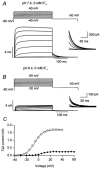


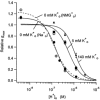

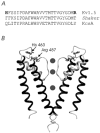

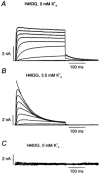
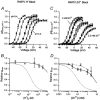
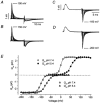
References
-
- Aiyar J, Withka JM, Rizzi JP, Singleton DH, Andrews GC, Lin W, Boyd J, Hanson DC, Simon M, Dethlefs B. Topology of the pore-region of a K+ channel revealed by the NMR-derived structures of scorpion toxins. Neuron. 1995;15:1169–1181. - PubMed
-
- Backx PH, Yue DT, Lawrence JH, Marban E, Tomaselli GF. Molecular localization of an ion-binding site within the pore of mammalian sodium channels. Science. 1992;257:248–251. - PubMed
-
- Baukrowitz T, Yellen G. Modulation of K+ current by frequency and external [K+]: A tale of two inactivation mechanisms. Neuron. 1995;15:951–960. - PubMed
-
- Blaustein RO, Cole PA, Williams C, Miller C. Tethered blockers as molecular ‘tape measures’ for a voltage-gated K+ channel. Nature Structural Biology. 2000;7:309–311. - PubMed
Publication types
MeSH terms
Substances
LinkOut - more resources
Full Text Sources
Research Materials

